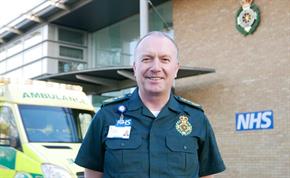
Last week we completed the formal inspection phase of the CQC inspection process. This follows previous stages including the submission of a portfolio of evidence (some 19,506 pages), regional focus groups, and stakeholder engagement. Part of the latter phase included engagement with bodies such as the Trust Development Authority, the clinical commissioning groups (CCG)s, NHS England, Health Education England (HEE), College of Emergency Medicine, NHS Litigation Authority, Parliamentary and Health Service Ombudsman, and the local Healthwatch.
We are now in the unannounced inspection period until Monday, 25th April; the inspection then moves into the reporting and reviewing phases when the report is drafted and the Trust has an opportunity to check the draft for factual errors. The key take home message is that we have completed some of this journey but have much more to do.

On behalf of the Trust, I want to thank everyone for all of their hard work which has brought us to this point. In particular, I want to thank Lewis Andrews and the Quality Development Team who have put in extraordinary effort to bring our Trust to a point where we can all proudly say, “Nothing to hide and lots to be proud of”.
The CQC inspection team has taken the opportunity to provide us with some high-level written feedback. In this week’s message I am providing you all with the feedback we have received in writing from the CQC regarding what they describe as “Areas of Good Practice” as well as “Areas of Concern”.
It is important to stress that this is INITIAL FEEDBACK and should not be interpreted as representing the final report. It is given to us in order to highlight areas we need to celebrate and share as best practice, as well as areas we need to take action on immediately. Basically, the CQC will expect us to act on those “Areas of Concern” immediately, even before any draft report is produced. These “Areas of Concern” will also be a key area of focus for CQC inspectors during the unannounced inspection phase. Essentially, if we fail to address these “Areas of Concern” immediately, this is likely to significantly influence the final report.
On a positive note, it appears that on balance, the CQC inspector’s preliminary feedback is predominantly positive. The following bullet points are COPIED VERBATIM from the letter we have received from the CQC. The language used is frank, as we’d expect from a rigorous inspection, and certainly gives a very strong perspective:
Areas of Good Practice:
Areas for Concern:

As I’ve outlined, we need to take action on these matters in the next two weeks and I have provided all Trust managers with a copy of the CQC’s letter of initial feedback on Wednesday.
The CQC inspection represents a significant milestone on our journey to become a more clinically-focussed organisation. The work we have had to do over the last eight months demonstrates there is much ground to recover before we can consider ourselves “Outstanding” across every domain. We need to have the capacity to drive this work forward and continue to ensure we uphold the professional standards expected of us by the people we serve.
In the coming months, our Quality Development Team will transition to be our ongoing Quality Improvement and Professional Standards Team, further evidence the Trust is committed to the highest standards of services to our patients.
While this team will lead the implementation of any action plan that may emerge in due course from the final report from the CQC inspection, they will also continue to drive forward our overall agenda to become a quality focussed ambulance service. This is a good time for the rest of us to really get behind team EEAST and push this on for both our staff and our patients.
Away from the CQC inspection, discussions on the late finish proposals to balance patient safety and staff wellbeing are continuing with our staffside colleagues, and I will provide more detail in next week’s update.
Have a good week
Robert
Published 14th April, 2016